Achatininae
Achatina
Strophocheilidae
Other Species
Slugs
Archachatina (Calachatina) marginata (Swainson, 1821)
West African Land Snail, Banana Rasp Snail, "Margie"
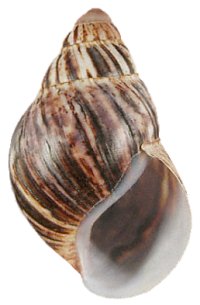
Archachatina marginata var. marginata (Note the Bluish-white columella, as shell pattern is not reliable at all).
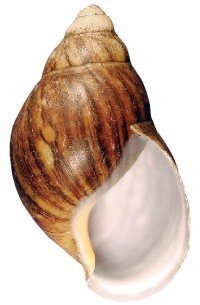
Archachatina marginata var. ovum (Note the apricot columella, as shell pattern is not reliable at all).
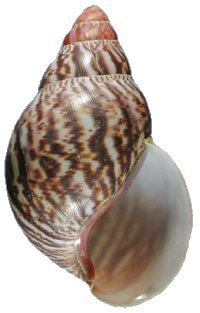
Archachatina marginata var. suturalis(Note the vinaceous columella, as shell pattern is not reliable at all).
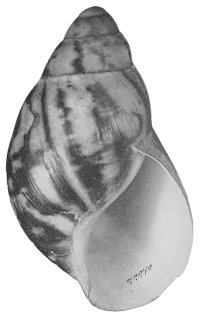
Archachatina marginata var. eduardi
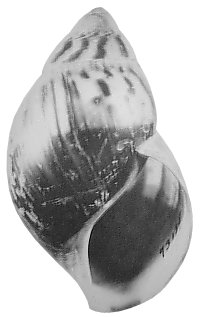
Archachatina marginata var. egregiella

Archachatina marginata var. egregia
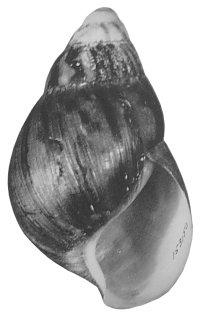
Archachatina marginata var. clenchi
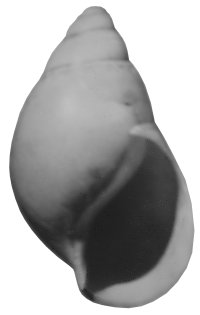
Archachatina marginata var. grevillei
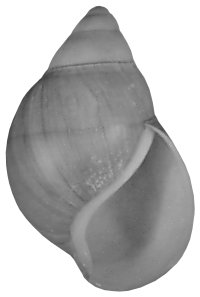
Archachatina marginata var. icterica
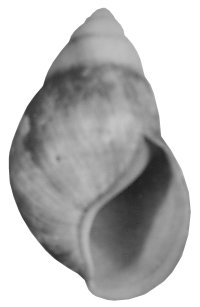
Archachatina marginata var. candefacta
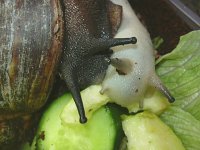
Picture courtesy of Gabi.
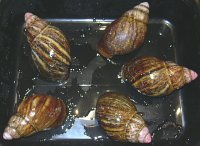
Picture courtesy of Gabi.
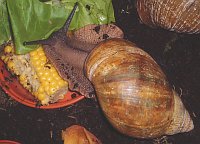
Archachatina marginata var. ovum
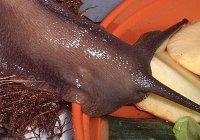
Archachatina marginata var. ovum
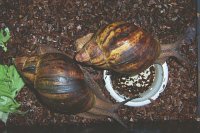
Picture courtesy of unknown (please tell me!)
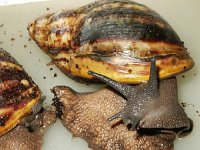
Picture courtesy of Kevin Davies.

Archachatina marginata var. suturalis
Archachatina marginata is the largest of the Archachatina snails and is found in West Africa. It appears to be a mainly terrestrial snail. In Cameroon it can be found aestivating under ground during the drier months, having a closed aperture, sealed with a solid, calcareous, white epiphragm.
It is to be noted that when a crawling snail is disturbed it produces a peculiar screaming noise, caused by the expulsion of air as the shell is rapidly retracting by the powerful columella muscle.
Natively, this species does not cause any appreciable damage to native crops and is actually considered an economic asset among many native peoples who include it in their diet. In many parts of West Africa, it is considered the second best snail to eat after Achatina achatina. They have been known to stow away on banana shipments and make it to Germany (Boettger, 1938).
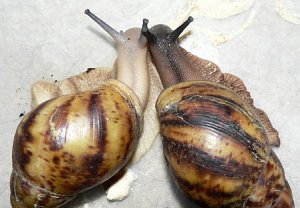 Picture courtesy of Evelyn Kretschmann
Picture courtesy of Evelyn Kretschmann
An albino-bodied form can be found and is actually becoming more common. This is because natives prefer to eat the dark-skinned ones, based on the belief that they are tastier and that there is something undesirable or freakish about the white-skinned ones.
It must be noted that in captivity, it is known that captive snails tend to be lighter than their wild counterparts and this is not the same thing.2
The shells of Archachatina marginata are used for domestic purposes by locals for salt holders and cups etc.
"A. marginata has evidently been dispersed by human agencies in West Africa, having recently invaded the south-west parts of Ghana (Monney, 1994). It has also been introduced to Annobón and São Tomé in the Gulf of Guinea (Gascoigne, 1994). On São Tomé it has become widespread and Gascoigne (1994) suggested that competitive interactions, along with habitat destruction, may have contributed to the decline in the indigenous Archachatina bicarinata (Bruguière)." 1
Identification

Archachatina have a raised V ridge on their tail that you can feel clearly if you run a wet finger over it. For more information on this see the Achatinidae Identification guide.
You'll also find the snail's skin to be more finely textured than Achatina, although this is less apparent near the tail. Unfortunately this can't tell you what type of Archachatina you have but it is the first step.
In addition to geographic locale, there are two main features distinguish the several variations of Archachatina marginata from the related members of the genus:
"The first is the subsutural, usually strongly marked engraved line, separated from the suture by a low narrow depressed area covered with irregular, low, vertical folds, the suture itself being straight or very slightly wavy, not crenulate. The engraved line starts on the fourth and fifth whorl and it is often deep and prominent, particularly on the body-whorl; but occasionally it is weak or almost lacking, especially in subsp. eduardi Pilsbry. The second feature is a peculiar microsculpture of the body-whorl, only visible with the proper magnification. It consists of numerous extremely fine, close-set, criss-cross or anatomising lines, making the surface of the periostracum look as if it had been pressed with a very finely woven cloth. This "weave" type of microsculpture is more pronounced in some forms or races than in others. It is particularly conspicuous when the periostracum is well developed and preserved, as is more common in some of the Cameroon races, such as subsp. egregia. In old shells, even when taken alive, the microsculpture is sometimes almost completely worn off, but traces of it may generally be detected in a few spots. The nepionic whorls, when well preserved, as in newly hatched or very young shells, are densely covered with regular spiral and vertical rows of minute granulations, which become coarser on the first, post-nepionic whorl." Studies in the Achatininae, a group of African land snails - Joseph C. Bequaert, 1950., p.140-141.
Sub-species (Common)
Historical Synonyms: Achatina (Achatina) marginata (Beck, 1837), Achatina (Achatinus) marginata (Pfeiffer, 1856), Achatina amphora (Catlow and Reeve, 1845), Achatina (Archachatina) marginata (Albers, 1850), Achatina (Archachatina) marginata var. foureaui (Germain, 1908), Achatina intuslalescens "Paiva" (Nobre, 1909), Achatina marginata (Swainson, 1821), Achatina paivana (Vignon, 1888), Achatina schweinfurthi var. foureaui (Germain, 1905), Archachatina aequatorialis (Dartevelle, 1939), Archachatina (Calachatina) marginata (C. R. Boettger, 1940), Archachatina marginata (Pilsbry, 1904), Archachatina marginata var, amphora (Pilsbry, 1904), Archachatina (Megachatina) marginata (Bequaert and Clench, 1936), Archachatina (Megachatina) marginata var. foureaui ("Germain" Dautzenberg, 1921), Archachatina (Megachatinops) gaboonensis var. aequatorialis (Bequaert and Clench, 1936), Buccinum parvum integrum (Gualtieri, 1742) [Described as synonym by Bequaert and Clench, 1936. Since shown to be Achatina achatina (Linné)], Cochlitoma marginata (G. B. Sowerby, 1825), Helix (Cochlitoma) amphora (Férussac, 1821), Helix (Cochlitoma) marginata (Rang, 1831), Oncaea marginata (Gistel/Gistl, 1848).
Shell fairly uniformly marked with numerous chestnut-brown or pale brown vertical streaks, stripes, zigzag lines, or blotches on a straw-yellow background. Large and broad, up to 176 mm. long. Columella, outer lip and parietal wall white or bluish-white. Apex pale coloured or roseate.
Locality: West Africa. Belgian Congo, Cameroon, Dahomey, Fernando Po, French Congo (Gaboon), Spanish Guinea, Nigeria (North and South). No reliable evidence that it is found West of Dahomey. Records from from Liberia and the Ivory Coast are doubtless Archachatina ventricosa.
Historical Synonyms: Achatina (Achatinus) ovum (Pffeifer, 1879), Achatina ovum (Pffeifer, 1858), Archachatina (Megachatinops) ovum (Bequaert and Clench, 1936), Archachatina ovum (Pilsbry, 1904).
Shell fairly uniformly marked with numerous chestnut-brown or pale brown vertical streaks, stripes, zigzag lines, or blotches on a straw-yellow background. Similar to nominate race in size (170 mm.), general outline and shape of aperture, as well as in sculpture, having also the characteristic "weave" microsculpture. Columella and parietal wall more or less extensively apricot-yellow, this colour extending upward over much of the glazed area of the parietal wall; a narrow outer zone of both parietal wall and columella remains blueish-white. The summit of the spire (first three whorls) also is often suffused with yellow or orange-yellow. Outer lip white or bluish-white.
Locality: Southern Nigeria (Lagos, Oloki Meji, Ibadan).
Historical Synonyms: Achatina (Achatinus) cummingii (Pfeiffer, 1879), Achatina (Archachatina) marginata var. gracilior (Germain, 1916), Achatina (Archachatina) marginata var. subsuturalis (Bofill and de Aguilaramat, 1924), Achatina cummingii (Shuttleworth, 1852), Achatina marginata (Reeve, 1849), Achatina marginata var. gracilior (d'Ailly, 1896), Achatina marginata var. subsuturalis (Hidalgo, 1910), Achatina suturalis (Philippi, 1849), Archachatina cummingii (Pilsbry, 1904), Archachatina (Magachatina) marginata var. suturalis (Bequaert and Clench, 1936), Archachatina marginata var. gracilior (Pilsbry, 1904), Archachatina marginata var. subsuturalis (Pilsbry, 1904), Bulla achatina (Huddesford, 1770), Bulla achatina var. marginata (Donovan, 1826).
Shell fairly uniformly marked with numerous chestnut-brown or pale brown vertical streaks, stripes, zigzag lines, or blotches on a straw-yellow background. Medium-sized to fairly large but usually more slender and with a narrower body-whorl than the typical form. Slightly smaller than nominate race, being usually about 110 mm. long and 60 mm. wide but have been known to reach 135 mm (and possibly higher [148 mm.] as suggested in a french study, see further reading for translation.) Immature shells are often more slender and lighter than nominate marginata of about the same age; but these differences tend to disappear with age. Columella and parietal wall more or less extensively vinaceous red. Apex usually, but not always reddish.
Comparison: Too broad for Archachatina purpurea, too smooth for Archachatina ventricosa, and with too narrow an aperture for Archachatina degneri.
Eggs: The lemon-yellow eggs are slightly smaller than nominate race, being 17.5 to 18 mm. long and 13 to 13.5 mm wide. There is some evidence that suturalis eggs are easier to hatch than the nominate race "marginata" and "ovum". This may be due to suturalis being found in São Tomé and Principe, perhaps one of the most temperate areas in Africa, off the West-Coast. The lower temperatures there may mean that eggs in captivity do not have to be so uniformly warm as is known to be the case for "ovum" in particular.2
Sub-species (Other)
Historical Synonyms: Achatina marginata var. gracilior (v. Martens, 1860), Achatina modestior (O. Boetgger, 1905), Archachatina marginata var. fourneaui (Spence, 1928), Archachatina marginata var. gracilior (Kobelt, 1910), Archachatina (Megachatinops) adelinae (Bequaert and Clench, 1936).
A particularly small or slow growing type. Shell fairly uniformly marked with numerous chestnut-brown or pale brown vertical streaks, stripes, zigzag lines, or blotches on a straw-yellow background. Small and usually slender for this species, up to 110 mm. long with relatively narrow aperture. Columella, parietal wall and outer lip bluish-white. Apex usually pale coloured.
Locality: West Africa: Ivory Coast (open to question), Cameroon, Fernando Po
Historical Synonyms: Archachatina (Magachatina) marginata var. egregiella (Bequaert and Clench, 1936).
Lower half of body-whorl, or of earlier whorls in immature shells, mostly very dark chestnut-brown, except for a narrow, well-defined straw-yellow zone at the base of the columella; remainder of shell (above the periphery) marked as in the typical form. Medium-sized and moderately broad, up to 110 mm. long. Columella, parietal wall and broad inner margin of outer lip vinaceous-red. Apex vinaceous-red.
Original description of egregiella Bequaert and Clench (1936): "Agrees in general type of coloration with var. egregia, but the first three whorls are vinaceous-red like the columella and the outer lip is broadly margined inside with the same vinaceous color. Length. 80 mm.; greatest width, 47.2 mm.; 5½ whorls."
Locality: Cameroon.
Historical Synonyms: Achatina (Archachatina) marginata var. egregia (Dautzenberg, 1921), Achatina marginata var. nigrofasciata "Theile" (Tessman, 1913), Archachatina (Magachatina) marginata var. egregia (Bequaert and Clench, 1936), Archachatina marginata var. (v. Martens, 1876).
Characterised by the broad dark chestnut-brown or nearly black transverse band which occupies most of the lower two-thirds of the body-whorl, beginning at the periphery and leaving only a narrow columellar area straw-colored. Upper part of body-whorl with relatively few chestnut wavy streaks or spots. Inner margin of columella vinaceous-red. Apex of spire pale yellowish or more or less roseate. Outer lip bluish-white inside over the paler, and darker bluish over the brown area. 110 mm. long, 65 mm. wide. 6½ whorls.
An interesting variant of egregia, from Loldorf, is fairly uniformly straw-yellow, with a few narrow, widely spaced pale brown vertical streaks on the penultimate and the upper part of the body-whorl; below the periphery the body-whorl is at first streaked like the upper part; but in the terminal half it has a fairly distinct, very pale-brown, darkened band, sharply set off in the usual manner from the straw-yellow base. Apical four whorls roseate. Columella and most of parietal wall intensely violaceous-red. Inner edge of outer lip white. 81 mm. long, 51 mm. wide, of 6 whorls, with the aperture 47.5 by 26 mm.
Lower half of body-whorl, or of earlier whorls in immature shells, mostly very dark chestnut-brown, except for a narrow, well-defined straw-yellow zone at the base of the columella; remainder of shell (above the periphery) marked as in the typical form. Medium-sized and moderately broad, up to 110 mm. long.
Columella and parietal wall vinaceous-red. Inner margin of outer lip bluish-white or darkened. Apex yellowish or slightly roseate.
Original description of egregiella Bequaert and Clench (1936): "Agrees in general type of coloration with var. egregia, but the first three whorls are vinaceous-red like the columella and the outer lip is broadly margined inside with the same vinaceous color. Length. 80 mm.; greatest width, 47.2 mm.; 5½ whorls."
Locality: Cameroon.
Agrees with egregia and egregiella in the colour pattern, having the same broad blackish-brown band over the lower half of the last whorl, sharply divided from the straw-yellow base. The dark band is, however, most complete behind the outer lip, being elsewhere more or less interrupted vertical, pale yellow streaks. Summit pale coloured or slightly roseate. Columella, parietal wall and inner edge of outer lip bluish-white, without any trace of violaceous
Locality: Cameroon.
Historical Synonyms: Achatina (Achatinus) grevillei (Pfeiffer, 1879), Achatina grevillei (Pfeiffer, 1860), Archachatina grevillei (Pilsbry, 1904), Archachatina grevillii (Kobelt, 1910), Archachatina (Magachatina) marginata var. grevillei (Bequeart and Clench, 1936), Archachatina marginata, albino variety (Boettger, 1905).
Shell mostly or uniformly straw-yellow or olive-yellow, without or with mere traces of darker markings. Large and broad, shaped like the typical form, up to 105 mm. long. Outer lip white or bluish-white. Apex, columella and parietal wall partly or mostly rose or vinaceous-red.
Locality: Southern Nigeria.
This form was originally described from an immature shell, from the Gaboon as "uniformly straw-yellow, also at apex, without any indication of streaks or spots. The interior of the aperture and upper part of the columella are slightly bluish." The type was 89.5 mm. long, 58 mm. in greatest width, of 5½ whorls, the aperture 60 by 32.5 mm.
Locality: Gaboon.
Historical Synonyms: Achatina (Megachatinops) adelinae var. candefacta (Bequaert and Clench, 1936), Archachatina modestior var. candefacta (Bequaert and Clench, 1938), Achatina marginata, albino variety (O. Boettger, 1905).
Original description "....complete absence of dark markings. First four whorls pale orange-yellow, the remainder of the shell unicolorous straw-yellow; inside of aperture and columella pure white. Shape and sculpture as in the typical form."
Subsp. candefacta has the characteristic "weave" microsculpture of marginata, of which no trace is to be found in papyracea (= adelinae).
84 mm. long; 49 mm. wide; Whorls, 6½.
Locality: Cameroon.
Care
Conditions in the general care guide are ample, but it should be noted that Archachatina prefer conditions much steadier, and perhaps a little wetter than average.
Breeding
Average longevity is about 4½ years. Early death may occur in the third year, most deaths between 4 and 5 years. A few individuals may survive to 7½ years and occasionally 10 years.
Young snails can show signs of sexual maturity at 9-10 months old; prominent genital opening and interest in other snails. The eggs are on average 20 mm. long (range 10.6 - 25.1 mm.) and the average width was 15.7 mm. The size of the eggs is directly related to the size of the snail. The average clutch size is about 8-9 eggs with 3 being a minimum and 16 being a maximum. Sometimes single infertile eggs are laid on the surface. Each animal can lay between 2-4 clutches per season. It would also seem that in captivity in the UK, with no seasonal variation control they show a major peak in egg-laying between May and June and a minor peak during September. It has been hypothesised that if that is a reflection of the wild (Nigeria), the snail would hatch at the beginning of the wet season, meaning the babies have a better chance of survival.
The development of the embryo is heavily affected by soil temperature and moisture. The best conditions seem to be in very damp soil at a temperature of 23°C. The variations in temperature are responsible for many embryonic deaths. At an air temperature of 26-28°C and an inch below the soil surface 17-19° the incubation time is 35-41 days. At an air temperature of 26-28°C and a soil temperature at 22.5-23°C incubation time is 29-35 days.
The hatchlings consume their own egg shell and then start eating their siblings shells. Usually one of the upper eggs hatches first followed, in the next 24 hours, by a second hatching in a similar position. The first one to hatch may take 24-36 hours to do so. All the viable eggs usually hatch within a week of the first.
The young snail tend to burrow underground for at least 7 days but this can be 10-14 days.2
Further Reading
Identification Profile Native Environment Life of Achatinidae in London (Nisbet, 1974) Reproduction, Growth and Longevity of Laboratory Archachatina marginata ovum (Plummer, 1975) [abridged version] French Study (Translation) Gallery Impact on Tropical Agriculture Parasite RecordsSources
Much of the information on this page was sourced of paraphrased from: Studies in the Achatininae. J. C. Bequaert., 1950.
- Raut, S. K.; Barker, G. M. 2002: Achatina fulica Bowdich and other Achatinidae as pests in tropical agriculture. In: Barker, G. M. ed. Molluscs as crop pests. Wallingford, CABI Publishing.
- Observations on the Reproduction, Growth and Longevity of a Laboratory Colony of Archachatina (Calachatina) Marginata (Swainson) Subspecies Ovum. Jenifer M. Plummer, 1975., Proc. malac. Soc. Lond. (175) 41, 395-413.


































